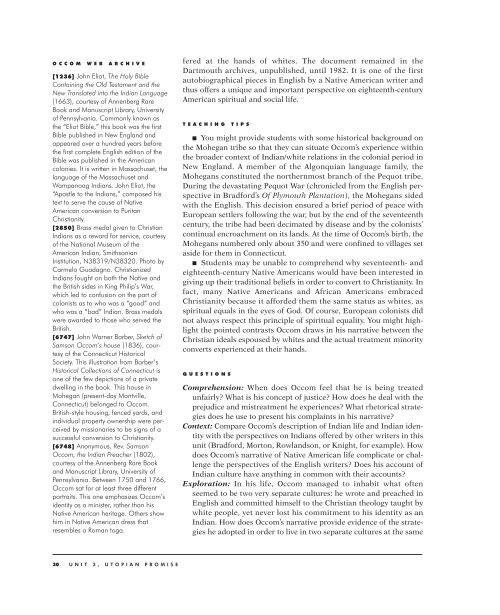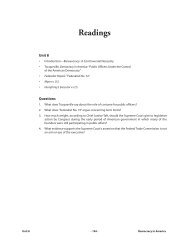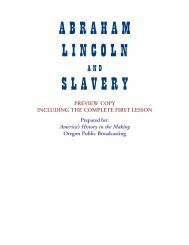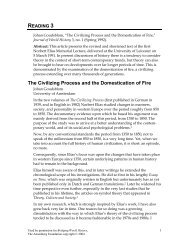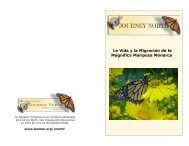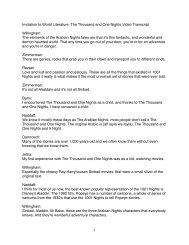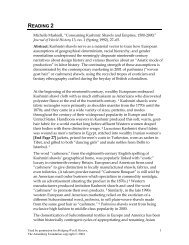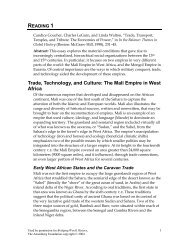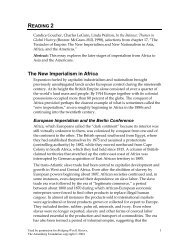UTOPIAN PROMISE - Annenberg Media
UTOPIAN PROMISE - Annenberg Media
UTOPIAN PROMISE - Annenberg Media
Create successful ePaper yourself
Turn your PDF publications into a flip-book with our unique Google optimized e-Paper software.
OCCOM WEB ARCHIVE<br />
[1236] John Eliot, The Holy Bible<br />
Containing the Old Testament and the<br />
New Translated into the Indian Language<br />
(1663), courtesy of <strong>Annenberg</strong> Rare<br />
Book and Manuscript Library, University<br />
of Pennsylvania. Commonly known as<br />
the “Eliot Bible,” this book was the first<br />
Bible published in New England and<br />
appeared over a hundred years before<br />
the first complete English edition of the<br />
Bible was published in the American<br />
colonies. It is written in Massachuset, the<br />
language of the Massachuset and<br />
Wampanoag Indians. John Eliot, the<br />
“Apostle to the Indians,” composed his<br />
text to serve the cause of Native<br />
American conversion to Puritan<br />
Christianity.<br />
[2850] Brass medal given to Christian<br />
Indians as a reward for service, courtesy<br />
of the National Museum of the<br />
American Indian, Smithsonian<br />
Institution, N38319/N38320. Photo by<br />
Carmelo Guadagno. Christianized<br />
Indians fought on both the Native and<br />
the British sides in King Philip’s War,<br />
which led to confusion on the part of<br />
colonists as to who was a “good” and<br />
who was a “bad” Indian. Brass medals<br />
were awarded to those who served the<br />
British.<br />
[6747] John Warner Barber, Sketch of<br />
Samson Occom’s house (1836), courtesy<br />
of the Connecticut Historical<br />
Society. This illustration from Barber’s<br />
Historical Collections of Connecticut is<br />
one of the few depictions of a private<br />
dwelling in the book. This house in<br />
Mohegan (present-day Montville,<br />
Connecticut) belonged to Occom.<br />
British-style housing, fenced yards, and<br />
individual property ownership were perceived<br />
by missionaries to be signs of a<br />
successful conversion to Christianity.<br />
[6748] Anonymous, Rev. Samson<br />
Occom, the Indian Preacher (1802),<br />
courtesy of the <strong>Annenberg</strong> Rare Book<br />
and Manuscript Library, University of<br />
Pennsylvania. Between 1750 and 1766,<br />
Occom sat for at least three different<br />
portraits. This one emphasizes Occom’s<br />
identity as a minister, rather than his<br />
Native American heritage. Others show<br />
him in Native American dress that<br />
resembles a Roman toga.<br />
30 UNIT 3, <strong>UTOPIAN</strong> <strong>PROMISE</strong><br />
fered at the hands of whites. The document remained in the<br />
Dartmouth archives, unpublished, until 1982. It is one of the first<br />
autobiographical pieces in English by a Native American writer and<br />
thus offers a unique and important perspective on eighteenth-century<br />
American spiritual and social life.<br />
TEACHING TIPS<br />
■ You might provide students with some historical background on<br />
the Mohegan tribe so that they can situate Occom’s experience within<br />
the broader context of Indian/white relations in the colonial period in<br />
New England. A member of the Algonquian language family, the<br />
Mohegans constituted the northernmost branch of the Pequot tribe.<br />
During the devastating Pequot War (chronicled from the English perspective<br />
in Bradford’s Of Plymouth Plantation), the Mohegans sided<br />
with the English. This decision ensured a brief period of peace with<br />
European settlers following the war, but by the end of the seventeenth<br />
century, the tribe had been decimated by disease and by the colonists’<br />
continual encroachment on its lands. At the time of Occom’s birth, the<br />
Mohegans numbered only about 350 and were confined to villages set<br />
aside for them in Connecticut.<br />
■ Students may be unable to comprehend why seventeenth- and<br />
eighteenth-century Native Americans would have been interested in<br />
giving up their traditional beliefs in order to convert to Christianity. In<br />
fact, many Native Americans and African Americans embraced<br />
Christianity because it afforded them the same status as whites, as<br />
spiritual equals in the eyes of God. Of course, European colonists did<br />
not always respect this principle of spiritual equality. You might highlight<br />
the pointed contrasts Occom draws in his narrative between the<br />
Christian ideals espoused by whites and the actual treatment minority<br />
converts experienced at their hands.<br />
QUESTIONS<br />
Comprehension: When does Occom feel that he is being treated<br />
unfairly? What is his concept of justice? How does he deal with the<br />
prejudice and mistreatment he experiences? What rhetorical strategies<br />
does he use to present his complaints in his narrative?<br />
Context: Compare Occom’s description of Indian life and Indian identity<br />
with the perspectives on Indians offered by other writers in this<br />
unit (Bradford, Morton, Rowlandson, or Knight, for example). How<br />
does Occom’s narrative of Native American life complicate or challenge<br />
the perspectives of the English writers? Does his account of<br />
Indian culture have anything in common with their accounts?<br />
Exploration: In his life, Occom managed to inhabit what often<br />
seemed to be two very separate cultures: he wrote and preached in<br />
English and committed himself to the Christian theology taught by<br />
white people, yet never lost his commitment to his identity as an<br />
Indian. How does Occom’s narrative provide evidence of the strategies<br />
he adopted in order to live in two separate cultures at the same


